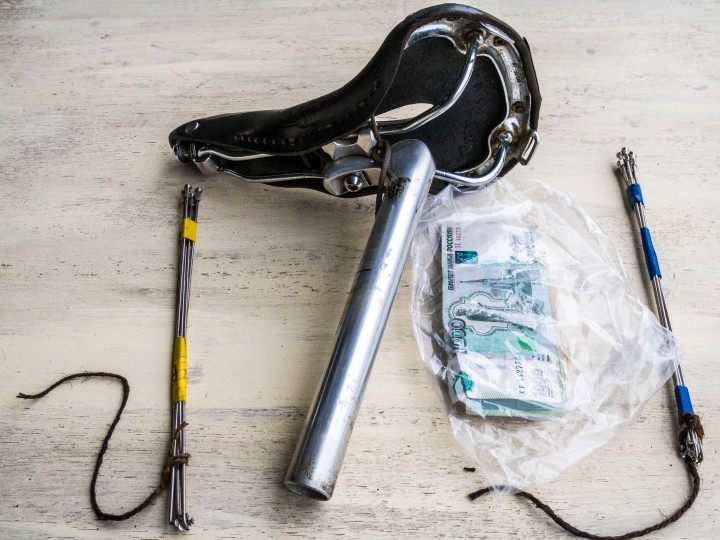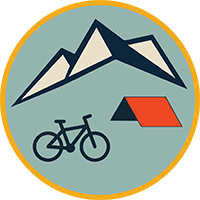Planning your cycle trip can prevent headaches later on down the road. A little preparation and organisation before you set off on your adventure will make your trip more enjoyable and stress free.
Hopefully the advice below will give you a helping hand along the way!
Useful apps
- Maps me (offline maps)
- Pocket Earth
- Warm showers (the couch surfing of cycle touring)
- Ride with GPS (good for planning routes and checking elevation)
- Google Drive (for storing information on the cloud)
- Vee (excellent video editing app)
Podcasts
For those lonely roads that stretch out as far as you can see! In no particular order:
TV for the ears!
- A History of the World in 100 objects – Short podcasts (about 15 minutes) that explains history through 100 manmade objects.
- Seriously – A great selection of documentaries with a strong emphasis on subcultures.
- Extra Pack of Peanuts Travel Podcast -A good resource for tips on how to travel cheaply, sustain a life of travel and been location independent.
- WTF with Marc Maron – Comedian Maron interviews everyone from hell raiser Keith Richards to former American president Barack Obama.
- Adam and Joe – I’d often find myself laughing out loud while listening to these guys. Boyish, meandering and ridiculous! Great fun!
- Desert Island Discs – A long running BBC radio show, started in 1942. Guests are interviewed and asked what eight records they would take with them to a desert island.
- Radiolab – Podcasts with diverse episodes that delves into philosophical debates, using real world examples and experiences.
- 99 % Invisible – A show about everything you would never consider for a podcast with using over looked subjects and bringing them together in a fun and interesting way.
Setting off from Japan
(We lived in Japan for a few years, the links below should help if you’re touring this beautiful country.)
Outdoor gear can be expensive in Japan. Here’s a list of useful resources:
- Second Street – check for stuff here before you look anywhere else. https://www.2ndstreet.jp/
- Rakuten – online shop. http://www.rakuten.co.jp/
- Amazon Japan – doesn’t always have what you’re looking for but shipping is free. http://www.amazon.co.jp/
- Campsaver – US company with free shipping to Japan if you buy over $400 worth of stuff. http://www.campsaver.com/
- Balba – Surly distributor in Kanazawa. http://www.balba.jp/store/kanazawa.html
- Montbell – outdoor shop with great quality gear and it’s not that pricey compared to imported stuff. http://en.montbell.jp/
- Kojitusanso – we have a members card for this outdoor shop. http://www.kojitusanso.jp/
- Google chrome – this browser translates Japanese to English making it easier to navigate websites.
- The touring store – We got a great deal on our panniers and Wayne couldn’t have been more helpful. http://www.thetouringstore.com/
Blogs we follow
- Travelling Two http://travellingtwo.com/
- Bikestronaut of the Western Steppe (Mongolia) by Ilan Goldstein https://www.crazyguyonabike.com/doc/?o=k1&doc_id=13810&v=K4#38173
- Lots and lots of knowledgable touring advice http://www.struck.us/CheckList/Bicycle_Touring_Tips.html
- Beautiful photographs http://goingslowly.com/
- A good mechanical resource site http://thebiketube.com/
- We met Harry and Veronica through warm showers. http://everydayadventureclub.tumblr.com/
- Rothar, bike cafe in Dublin Rothar
- Cycling and hiking adventures of Shane! Shane Cycles
- A great blog of eclectic bicycle related stories with an emphasis on the classic and handmade. Based in the beautiful Donegal in the North West of Ireland. Lovely Bicycle
Travel Insurance
While living in Japan it was a little tricky to find a travel insurance company that would cover us. The insurance company at the time stated that we technically already started travelling because we live in Japan. After a lot of research we final settled on True Traveller who cover people who have already left home. We got their adventure package which covers cycle touring.
We also applied for a free European Health Insurance card or EHIC.
Security and Hidden Storage
Cycling is a fantastic way to meet people and experience different cultures. 99% of the time people are friendly, generous and helpful. Unfortunately, occasions may arise when your security is at risk. It is a good idea to prepare in advance for such an occasion.
When we travel we keep our passport, money and identification close to our body by using a security waist wallet and keep it under our clothing. We keep a fake wallet in our handlebar bag, with some spare cash notes, old, no longer in use credit cards and old student cards or other form of obsolete id. It’s this fake wallet we would give if we were ever robbed.
We also use our seat post for secret storage. We carry spare spokes, labeled yellow for the front wheel and blue for the back wheel. Additionally we keep some cash wrapped in a plastic sandwich bag in the seat post too. This stash of cash is for emergencies only. We travelled from Mongolia to Ireland without ever having to use any of our secret cash.

We keep a combination of dollars, euros and local currency in the seat post. No more than $200s or €100s.

aMake sure the cash and spokes fit snuggly into the seat post. You don’t want it to be loose and rattling around as you cycle. Tie a string to the end of your contents and test that you can pull the spokes, cash etc out again before you attach your seat post back to your bike.

Cash hidaway!
Powering our Devices
We’ll be traveling through many places where we won’t have access to electricity to charge our various gadgets, as appealing as it is to be off the grid for a while, there are times when listening to your iPod or reading your kindle is welcome. Also we use iPhone apps such as Maps.me and Pocket Earth for navigation, so we need to keep our iPhone charged too.
Ciaran has a Shutter Precision Dynamo Hub installed on his front wheel which is attached to a Sinewaves Cycles Revolution USB charger. From here he can charge devices as he cycles.
Alternatively he can charge a cache battery with the hub and from the battery charge devices when camp is set up. We use an Anker 2nd Gen Astro 5 battery.
Cleaning and Hygiene
Sometimes we just can’t waste water washing cooking utensils.
A lot of our cleaning is done by baking soda and a little, flexible rubber spatula. We sprinkle a small amount on our pots and pans and it generally does a great job absorbing food grease and dirt and then use the rubber spatula to scoop it out. We also use baking soda for cleaning our clothes and if we are really stuck, ourselves!
Bike Stand
It can be very awkward holding your bike upright sometimes, so Ciaran carries this piece of high tech wizardry … a stick, or a ‘shhtick’ if your from Galway!
Bikes on a Plane!
Definitely the most stressful part of cycle touring for us has been dealing with airlines and preparing the bikes for flights.
On two occasions we were stopped at luggage check-in to be told we’re not allowed on the plane with our bikes. We were saved on both occasions by producing a previously sent email to the airline asking advice or declaring we’d be traveling with bikes and stating our bike dimensions and weight. It really pays to contact the airline in advance and save the email for offline use, to show you actually made contact with the airline. Also we advise phoning in advance, stating your flight booking reference number, and again letting the airline know you’re coming with bikes. The phone calls are recorded and because you gave your reference number should be logged. If there’s any problems at check-in produce both corresponding emails and proof of phone call.
Box or bag?
We’ve both boxed and bagged our bikes for air travel and we actually think bagging was the best option.
We generally use heavy duty plastic and duct tape you can pick up at a hardware store. Turning the handle bars, taking off the pedals, deflating the tyres, lowering the seat post, padding/protecting sensitive parts of the bike, and wrapping it in plastic only takes a few minutes, you could actually cycle to the airport and do all the above there.
Boxes are a lot more cumbersome and take up more room than the bags, additionally they are obviously heavier than bags. However one advantage of using boxes is you can stuff some clothes, gear, etc in with the bike, as long as it’s under the weight limit, to free up space in your other check-in bags.

We think the bikes are treated with more care by airline staff when they can see what’s inside the bags.

Also bagging your bike takes up less space than boxing them.

Our bagged bikes with their very own separate trailer.

Laura keeping a watchfful eye on the bikes and gear…
Big and bulky, the boxes not my biceps!
Stoves
I’ve been using an MSR Dragonfly everyday for the last couple of months to cook breakfast, dinner and tea! Overall it’s performed ok, but recently it’s been raising my blood pressure to boiling point rather than my pot of pasta! I think it may need a new filter, but I’m finding it pretty hard to locate one here in Eastern Europe. It’s not performing as it should. ( Update: When i got back to Ireland i discovered the problem with my MSR stove; find out here.)
 Luckily, I packed this little beaut.
Luckily, I packed this little beaut.
This is a simple alcohol stove, it’s a very simple design, no parts to change or clean. There are numerous instructions online on how to make one so I won’t go into the details here.
I’ve been using rubbing alcohol, which is readily available in pharmacies. The stove is silent and clean. It’s actually ideal for stealthy camping, when you don’t want to be disturbed as you hungrily prepare your dinner whilst hiding in the bushes… nothing strange about that of course!

The wind shield is also a good pot stabd.

When the fuel is sufficiently heated, the centre flame jets through the ring of holes along the top of the stove.
Navigation
We couldn’t find any information online about an offline map for the euro velo routes and the signs along the route aren’t always reliable. We ended up importing a gpx file of the route we needed to the pocket earth app which allows us to view it offline.
I would love to hear your own advice and tips!
Please feel free to leave a comment!








Pingback: How do you clean pots with no water?! – Crank & Cog